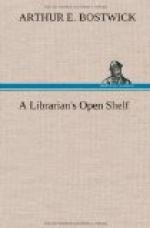This simple statement of facts will grieve many good people, but to omit it would be false to the truth and dishonorable to the flag that we honor today.
Its origin, as we have seen, was in its service as a rallying point in battle. We are still battling, and we still need it. And at times our contests still inevitably take the physical form. One may earnestly pray for peace; one may even pay his dues to the Peace Society and still realize that to preserve peace we may have to use the sword.
Northward, across the Canadian border, good men[11] are striving even now to keep us in peace and to assure peace to a neighbor severely torn by internal conflict. Can any of us doubt that our good friend and fellow-citizen—nay, can anyone doubt that our neighbors of the Southern Continent—are doing their best to save human lives, to preserve our young men and the young men of Mexico to build and operate machines, to raise crops and to rebuild and beautify cities, instead of sending them to fill soldiers’ graves, as our bravest and best did in the “sixties?” And yet, should they succeed, as God grant they may, who can doubt that what will give strength and effect to their decisions will be the possibility of force, exerted in a righteous cause, symbolized by the flag? Who can be sorry that back of the flag there are earnest men; nay, that there are ships there, and guns? One need not be a Jingo; one can hate war and love peace with all one’s heart and yet rejoice that the flag symbolizes authority—the ability to back up a decision without which the mind itself cannot decide in calmness and impartiality.
[11] United States and “A-B-C” Commissions on the State of Mexico.
Surely, to say that the flag stands for the exertion of force, is only to say that it stands for peace; for it is by force only, or by the possibility of it, that peace is assured and maintained.
These are a few of the many things for which our flag of the Stars and Stripes stands. We are right to doff our hats when it passes; we are right to love it and to reverence it, for in so doing we are reverencing union, patriotism, liberty and justice. That it shall never become an empty symbol; that it shall never wave over a land disunited, animated by hate, shackled by indifference and feebleness, permeated by injustice, unable to exert that salutary strength which alone can preserve peace without and within—this is for us to see and for our children and grandchildren. We must not only exercise that “eternal vigilance” of which the fathers spoke, but we must be eternally ready, eternally active. The Star-Spangled Banner! Long may it wave over a land whose sons and daughters are both free and brave—free because they are brave, and brave because they are free, and both because they are true children of that eternal father without whom both freedom and bravery are but empty names.




